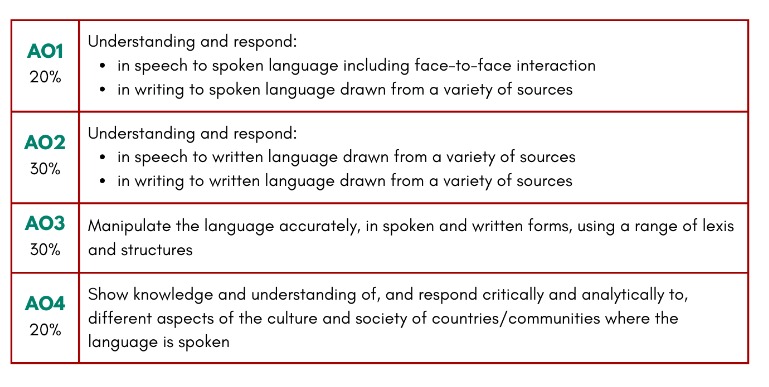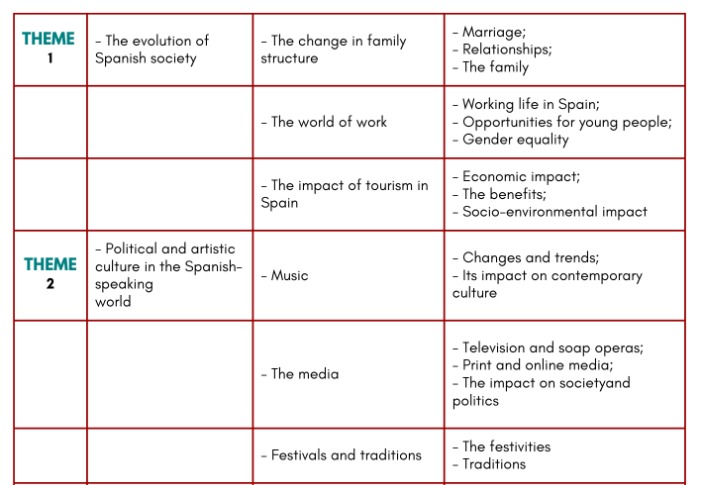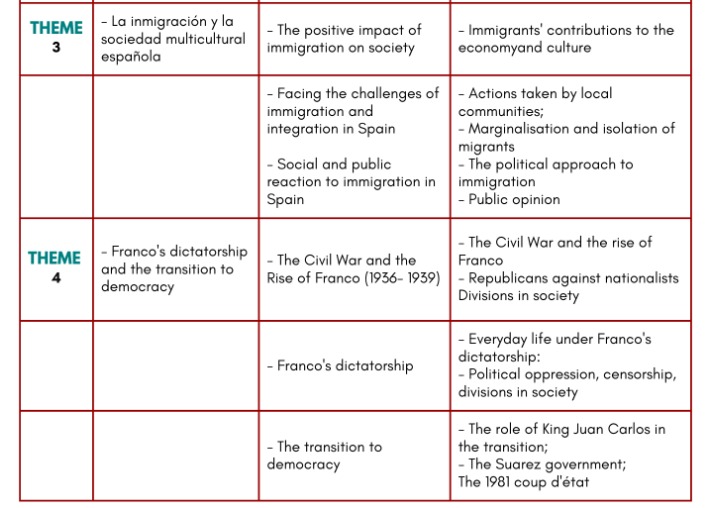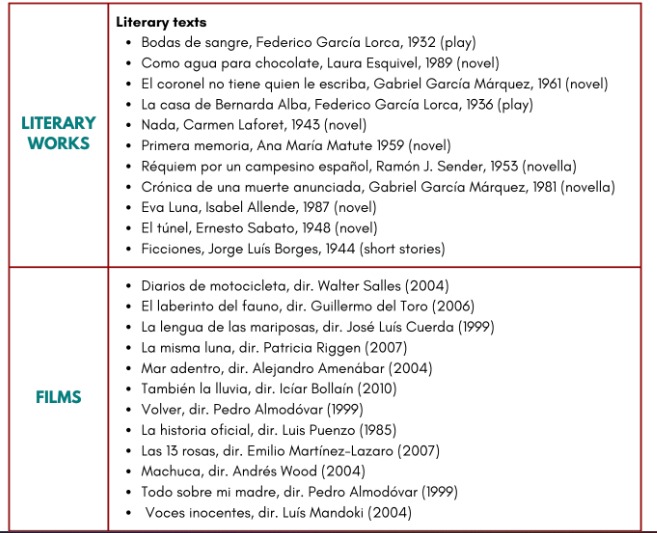

The A-level qualification, including the Level 3 Advanced GCE in Spanish, aims to be engaging for students while preparing them for further study and career paths.
It offers a structured approach to develop advanced language skills and deepen cultural understanding of Spanish and Hispanic cultures. The focus is on grammar to facilitate spontaneous, creative language use.
Themes are relevant, mixing traditional and contemporary materials, including a range of texts and films from Spanish Express to expand knowledge and encourage discussions on topical issues.
Since 2016, A-level Spanish has been fully linear, requiring all exams and assessments to be completed at the end of the course.
This structure promotes a well-structured understanding of Spanish and enhances students’ ability to produce clear explanations, describe experiences, and recognize implicit meanings.
The curriculum supports learners in using cohesive devices and engaging in regular interaction, preparing them to navigate complex linguistic and cultural discussions confidently.
Assessment objectives Specification Overview
Specification Overview Specification content
Specification content
The content of specifications is based on social, political, and cultural themes related to the Spanish language, culture, and communities.
This will allow students to gain a deeper understanding of the culture associated with their language of study while also ensuring a smooth transition to further study. The themes and assessment model are also intended to help students develop transferable skills.
The four themes
Theme 1: The evolution of Spanish society
Theme 2: Political and artistic culture in the Spanish-speaking world
Theme 3: Immigration historically and contemporarily
Theme 4: Franco’s dictatorship and the transition to democracy
There are a number of sub-themes, which can be found below. The content of these themes is assessed in Paper 1 (listening, reading, and translation) and Paper 3 (speaking).
Students at A level are also required to study either two texts or one text and one film, which will be assessed in Paper 2 (writing).
Moreover, A-level students will also be required to undertake an Independent Research Project, which will be assessed in the second part of the speaking exam.
The four themes and sub-themes in more detail

Prescribed literary texts and films
Themes 1, 3, and 4 relate to Spain only. Theme 2 relates to the wider Spanish-speaking world. This means that in the listening, reading, and translation papers, the content may be related to a country other than Spain, though only standard Spanish will be used.
Assessment overview
Written examination: 2 hours
40% of the qualification
80 marks
Section A is a Listening assessment based on a recording, featuring male and female Spanish speakers, covering Themes 1, 2, 3 and 4. Students will respond to comprehension questions in the target language, based on a variety of contexts and sources.
Question formats require multiple-choice and open responses. Responses in the target language are required, but students will not be marked on their quality of language.
Section B is a reading assessment based on a variety of text types and genres, including historical and literary texts.
Question formats require both multiple-choice and open responses. Questions are set in Spanish and responses in Spanish are required, though students will not be marked on their quality of language.
Section C is a translation into English. This will be an unseen passage.
Paper 2: Written response to works and translation
Written examination: 2 hours and 40 minutes
30% of the qualification
120 marks
Section A is a translation into Spanish. The content of the passage is related to any of the four themes.
Sections B and C comprise a written response to works. At A level, students are required to respond to two questions on two different works.
The works may comprise one book and one film, or two books. The works are listed above: Prescribed literary texts and films. The literary texts listed include a range of novels, plays, and a series of short stories. All of the films are feature-length.
There are two questions for each work and students choose one for each of their chosen works.
Paper 3: Speaking
The speaking assessment is conducted internally or by a visiting examiner and is externally assessed. 30% of the qualification.
Total assessment time: between 21 and 23 minutes, which includes 5 minutes of formal preparation time.
Task 1 requires students to choose one theme from a choice of two (these can be any of the four themes). They will then discuss one of the two statements on their chosen stimulus.
Task 2 is the Independent Research Presentation and requires students to give a short summary of their chosen topic, followed by a discussion with the examiner on their research.
Pearson Edexcel GCE
A Level Exam Dates for Summer 2024
| Subject | Exam code | Title | Date | Hour | Duration |
| Spanish | 9SP0 01 | Paper 1: Listening, reading and translation | Wednesday 07 June | Morning | 2h 00m |
| Spanish | 9SP0 02 | Paper 2: Written response to works and translation | Wednesday 14 June | Morning | 2h 40m |
| 9SP0 03 | Paper 3: Speaking | *PLEASE SEE BELOW |
Assessments are done by teacher-examiners in centers, in one session within five weeks in April and May. This test phase evaluates Spanish level and vocabulary, focusing on recognizing implicit meaning and topical issues.
How can Spanish Express help you with your Spanish A level?
If you found today’s article useful, then check out this interesting offer Spanish Express has for you. 😉
Thanks to the Spanish Homestay Immersion Programme (SHIP) you can immerse yourself in Spanish culture and learn the language in one of our teachers’ homes. 😀
Travel to Spain and live an amazing learning experience! 🇪🇸
It is an ideal way to learn Spanish and experience an unforgettable adventure. ✈️
Additionally, we have other interesting options: the Spanish Exams and the Spanish Film & Literature Workshops. If you want to learn Spanish in a fun and effective way, these alternatives are highly recommended. 🎬
Finally, in case you prefer a more personal tutoring focused on your academic goals, we recommend the Spanish A-Level Online Programme. 🎬
Learn Spanish with us!
What is a Level 3 advanced GCE qualification equivalent to?
A Level 3 Advanced GCE qualification is like finishing the last part of high school. It gets you ready for college or jobs by teaching you about complex subjects and improving your ability to handle detailed text and abstract topics.
What is the GCE A level equivalent in the USA?
In the USA, the GCE A level is similar to Advanced Placement (AP) courses or the first year of college. It shows you understand a subject well, often at a professional level, and can discuss complex situations.
What is the advanced GCE level?
The Advanced GCE Level focuses on studying subjects in a deeper way. It prepares you for the future by teaching you how to use language flexibly, understand complex text, and engage in technical discussions.
What is the Spanish equivalent of A level?
In Spain, the “Bachillerato” is similar to the A Level. It’s a two-year course that gets students ready for university or vocational training, emphasizing a broad understanding of complex subjects and the ability to communicate effectively with native speakers.
How hard is Spanish A level?
Spanish A level is a step up, requiring you to express ideas fluently and tackle complex subjects. It involves recognizing implicit meaning and differentiating finer shades of language, demanding both dedication and a passion for the language.
What does the Spanish A level consist of?
This level covers a wide range, from understanding the main ideas in complex texts to engaging in detailed discussions. It tests your ability to use Spanish flexibly for various options, including personal interest and professional purposes.
What can you do with a Spanish A level?
Holding a Spanish A level opens many doors for professional development. And it allows for regular interaction with native speakers in both simple and most complex situations. It’s valuable for careers where controlled use of language and understanding organizational patterns are key.













